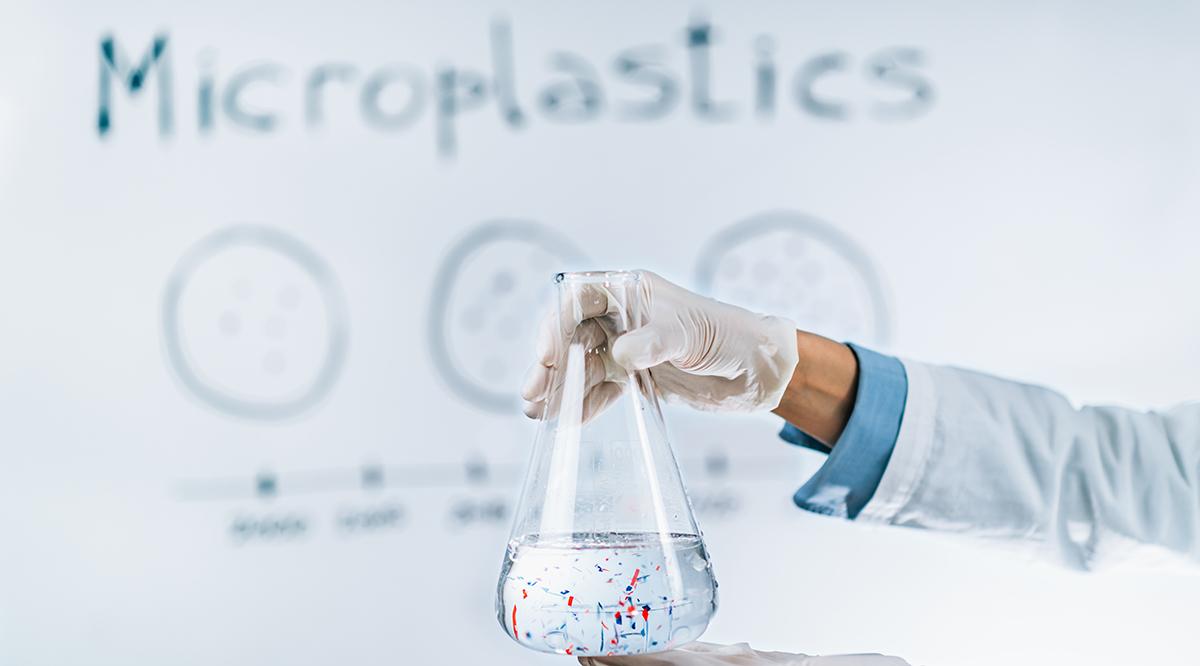When Jaime Ross, PhD, a neuroscientist and assistant professor at the University of Rhode Island College of Pharmacy, decided to study how contaminating the drinking water of mice with tiny fragments of plastic might affect their cognitive function, she didn’t expect the experiment to yield much.
But in just three weeks, Ross and her team found microplastics had made their way into the mice’s brains, passing the robust defenses of the blood-brain barrier. The researchers performed a variety of tests and found that the microplastic-exposed mice started exhibiting signs of cognitive decline similar to dementia.
“I didn’t really think we were going to see anything,” Ross says. But when they examined the mice’s tissues, they were shocked. “Every one we looked at we found the microplastics. It was surprising, especially finding them in the brain. Things are not supposed to go there!”
The research findings from Ross’ team, published in August 2023, add to a slew of recent studies pointing to an alarming trend: microplastics are everywhere. Minuscule plastic particles that come from degraded plastic products are found throughout the environment. Scientists estimate there are 8-10 million metric tons of plastics in the oceans, and some of that is consumed by fish and other wildlife. Microplastics have been detected in fruits and vegetables, plastic water bottles, the air, cosmetics, and household dust. Now, researchers are finding them in almost every part of the human body, including in breast milk, the placenta, testicles, hearts, livers, and kidneys.
Despite these findings, experts say that little is known and understood about what impact these microplastics have on human health. A few studies have drawn associations between microplastics and poor health outcomes, including cardiovascular disease and low male fertility. And chemicals often found in plastics are known to cause a variety of health problems, including cancers, metabolic disorders, attention deficit/hyperactivity disorder, and fertility issues.
But most of the studies raising alarm have been in labs or in animal models that don’t give a complete picture of the effect on humans, says Mary Margaret Johnson, MD, PhD, a principal research scientist of environmental health at Harvard T.H. Chan School of Public Health in Boston.
“I do think there needs to be more funding devoted to researching how it really is impacting our organs and disease itself,” she says.
What are microplastics?
Though plastics have become ubiquitous in modern life, they weren’t invented until the mid-1800s and weren’t produced on a large scale until the 1950s. Over the past century, technology to create a huge variety of malleable polymers (chains of large, repeating molecules) has evolved into the umbrella term plastics, which are often derived from petroleum and other fossil fuels, according to the Science History Institute in Philadelphia.
Plastics are used in most containers and packaging materials; in most of the fabrics that make clothing, bedding, carpeting, and towels; in the construction of buildings and motor vehicles; and in many of the materials used in health care settings to prevent the spread of infection, among many other uses.
The production of plastics worldwide has doubled in the last two decades, according to Our World in Data. Plastic’s versatility, durability, and low weight-to-strength ratio have made it an efficient material for many of life’s modern conveniences. However, by their nature, plastics can break down and degrade into smaller pieces. At the same time, scientists have found that plastic materials can exist for decades, if not longer, without completely disintegrating.
Scientists have studied the impact of plastic on the ecological environment for decades and have raised concerns about the health effects of some chemicals used in plastics. But it’s only within the last several years that researchers have discovered the extent to which microplastics (which range from 1 nanometer, 1/80,000 the width of a strand of hair, to 5 millimeters, the size of a pencil-top eraser) and nanoplastics (which are even smaller and invisible) have become embedded in the environment and in human bodies, explains Tracey Woodruff, PhD, MPH, a professor in the Department of Obstetrics, Gynecology, and Reproductive Sciences and director of the Program on Reproductive Health and the Environment at the University of California San Francisco (UCSF) School of Medicine.
Woodruff, who has studied the effect of some chemicals found in plastics on human health, reproduction, and development for two decades, first started looking into microplastics in 2021. She and a group of scientists from across the University of California system reviewed hundreds of existing studies on microplastics and health and compiled a report for state lawmakers to consider during policymaking. Though mostly based on animal studies, Woodruff and her colleagues concluded that there was evidence that microplastics could harm fertility and increase cancer risk in humans.
“Governments have not really fully figured out what they’re going to do about this,” Woodruff says. There have been some efforts to ban the use of plastic microbeads in cosmetics, but not much beyond that, she adds.
Red flags for human health
While there haven’t yet been any definitive studies showing that microplastics cause health problems in humans, researchers have identified several red flags that call for further investigation.
In Ross’ research in mice, for example, the scientists used plastic particles that were “clean,” meaning that they did not have any of the known toxic chemicals found in many plastics and they were also free of bacteria and viruses that microplastics can pick up from environmental exposure. And yet, with the mere presence of the microplastics, the mice began to experience negative effects. This could be because the immune system recognizes the presence of a foreign invader and triggers inflammation, which can have a negative effect on a range of organs.
“We just wanted to see the effect of plastic itself, but that’s not what is really in the environment,” Ross says. “Plastics in the environment are not this way; they’re not pristine.”
Ross’ work has raised even more questions about microplastics in the body.
“We’re trying to understand: How are they getting into the brain? What do they do? Where do they go? Do they get out?” she says.
Sheela Sathyanarayana, MD, MPH, a professor in the University of Washington Department of Pediatrics and the Department of Environmental and Occupational Health Sciences, worries that the harm from microplastics in the body could be compounded by what are known as endocrine disrupting chemicals that are found in many plastics.
Bisphenol A (BPA), phthalates, and per- and polyfluoroalkyl substances (PFAS) are just a few of the chemicals known to imitate hormones and disrupt the body’s natural endocrine system, which is responsible for making the hormones that govern processes such as growth and development, metabolism, appetite, mood, and certain aspects of reproduction.
Sathyanarayana has focused her research on studying the impact of exposure to endocrine disrupting chemicals on reproduction and has found that they can have a profound impact, especially during fetal development.
“That’s when organ development is happening; that’s when programming for later life happens,” Sathyanarayana says. “Whatever happens during pregnancy will affect your later life and health for the whole continuum.”
She gave the example of research that found some women who experience famine while pregnant later have babies who experience obesity, likely because of the effect their mothers’ starvation has on the development of the babies’ metabolism.
Fetal exposure to endocrine disrupting chemicals has been associated with abnormal development of reproductive organs in male babies, with increased risk of metabolic disorders in childhood, and may be associated with the child developing attention deficit hyperactivity disorder (ADHD). Some of these chemicals have also been linked to lower sperm quality in men.
Woodruff also raises the concern that rising rates of younger people diagnosed with colon cancer and other cancers related to the gastrointestinal tract could be linked to ingested plastics and other chemicals.
“I always recommend to people, try to reduce your plastic exposure as much as possible,” Sathyanarayana says.
Reducing plastic in the world and at home
Because plastics are in almost every part of modern life, it’s extremely difficult to eliminate exposures, Sathyanarayana acknowledges, but she has found ways to reduce her own.
She carries a stainless-steel water bottle and avoids plastic water bottles. She doesn’t microwave food in plastic containers and only uses glass, wood, or metal kitchen items, including mixing bowls, spoons, cutting boards, and food storage containers.
In her home, Sathyanarayana also takes her shoes off to avoid tracking in dust from the outside and uses a HEPA filter to capture particles from the air.
The Program on Reproductive Health and the Environment at UCSF offers additional tips to help minimize exposure to toxic chemicals, like those sometimes found in microplastics.
But Sathyanarayana admits there are some things that are tough to relinquish. For example, though most of her clothes are made of non-plastic cotton and wool, some of her clothes are made of plastic fibers, like the spandex, polyester, and nylon in her activewear.
“The reality is we can’t avoid plastics,” she says. “No one can.”
That’s why the bulk of the responsibility for reducing microplastics exposure is on governments and manufacturers, Woodruff says. For example, regulatory bodies could require washing machines to include filters that catch microplastics coming from clothing. Or even better, clothing manufacturers could use less plastic, she says.
But there’s still a lot of research and discussion that needs to happen to help policymakers understand the best way forward, Ross says.
“I don’t want to demonize plastics; they’re quite important,” Ross says, adding that they have been lifesaving in health care settings. “But do we really need our vegetables wrapped in plastic at the grocery store? Let’s have a conversation about what we really need plastic for.”

